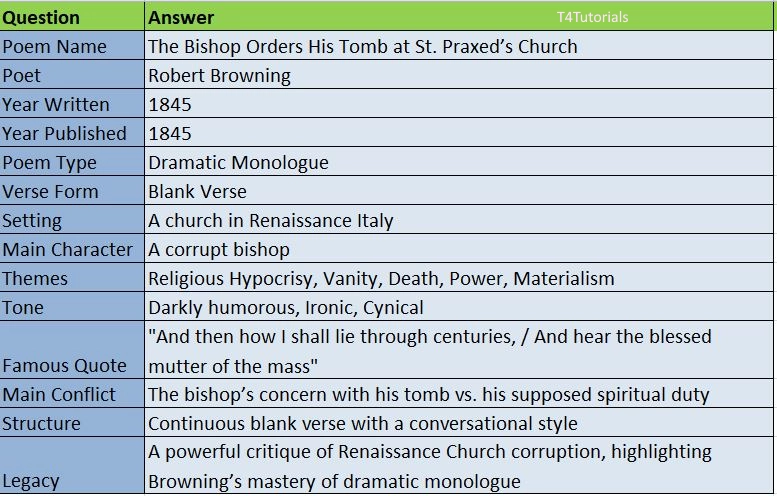Summary:
Robert Browning’s “The Bishop Orders His Tomb at St. Praxed’s Church” is a dramatic monologue written in 1845. The poem features a corrupt and materialistic Renaissance bishop on his deathbed, giving detailed instructions about how he wants his tomb to be constructed. He is obsessed with wealth, status, and legacy, showing little concern for spiritual matters. His monologue reflects the hypocrisy of the Church during the Renaissance, as he envies his rival, Gandolf, and desires an extravagant tomb to outshine him. The poem critiques religious corruption, vanity, and the human obsession with legacy.
10
Score: 0
Attempted: 0/10
Subscribe
| Question | Answer |
| Poem Name | The Bishop Orders His Tomb at St. Praxed’s Church |
| Poet | Robert Browning |
| Year Written | 1845 |
| Year Published | 1845 |
| Poem Type | Dramatic Monologue |
| Verse Form | Blank Verse |
| Setting | A church in Renaissance Italy |
| Main Character | A corrupt bishop |
| Themes | Religious Hypocrisy, Vanity, Death, Power, Materialism |
| Tone | Darkly humorous, Ironic, Cynical |
| Famous Quote | “And then how I shall lie through centuries, / And hear the blessed mutter of the mass” |
| Main Conflict | The bishop’s concern with his tomb vs. his supposed spiritual duty |
| Structure | Continuous blank verse with a conversational style |
| Legacy | A powerful critique of Renaissance Church corruption, highlighting Browning’s mastery of dramatic monologue |